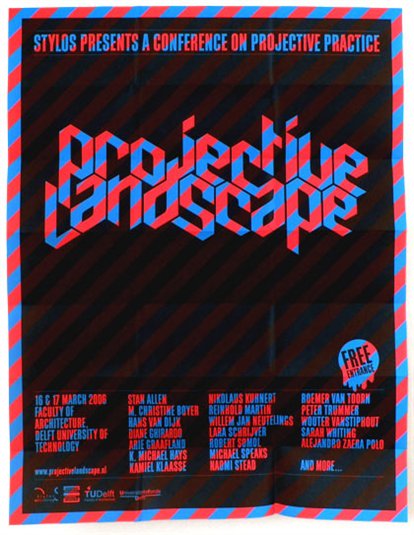In 2004 Jasper de Haan en Lara Schrijver started a series of extracurricular seminars for a group of students at the Faculty of Architecture in Delft, loosely organised around Edwin Gardner and Stylos, who were interested in the most recent developments in architectural theory and thinking. Since Jasper de Haan initiated the conference and book The Critical Landscape soon the idea came
up to organise such an event again with the title: The Projective Landscape. The field, sadly enough, had hardly changed since 1994. And exactly that problem was the theme of this sequel to the Critical landscape. Is it possible to formulate an alternative for the overly present Hegelian, dialectic, Neo-Marxistic way of thinking based primarily on negation.
This time we invited: Michael Hays, Michael Speaks, Arie Graafland, Bob Somol, Sarah Whiting, Stan Allen, Christine Boyer, Reinhold Martin, Robert Somol, Roemer van Toorn, Kamiel Klaasse, Peter Trummer, Nikolaus Kuhnert, Hans van Dijk, Ole W. Fischer, Wouter Vanstiphout, Willem-Jan Neutelings, Naomi Stead and Lara Schrijver.
Below is the problem statement of the conference.

The current debate on a ‘post-critical’ architecture, often called ‘projective practice’ or ‘projective theory,’ has largely been held within an American theory forum. There are however strong connections between this and various European debates on such terms as ‘operative optimism’ and ‘new pragmatism.’ The main connections revolve around a certain optimism and a deep interest in the practice of architecture in the 21st century. Although the American debate seems extremely geared towards a reaction against the architecture and theory of Peter Eisenman, the European debate reflects a certain architectural praxis: an understanding that the capacity of ‘critical’ architecture only reaches so far, and that to address contemporary conditions a different set of tools may be necessary than the relatively common notions of societal criticism.
There is a sense of urgency and a sense of idealism, but both are conjoined with an interest in building, in navigating the complexity of 21st century reality without retreating into a self-enclosed design theory. This architecture is meant to be both idealist and pragmatist. It often takes serious account of such questions as collective values, while at the same time it is firmly embedded in the craft of the discipline itself. Its distantiation from 20th century ‘critical’ architecture is not merely a turn to affirmative and ‘easy’ commercial architecture. Rather, it questions these categories on a fundamental level, and is seeking out a new approach, that can both accommodate the complexity of the contemporary as well as take a position and not merely register reality. In this sense it is the problem of the postmodern condition itself: what certainties are there in a world that has lost its absolute values?
There is a sense that all these questions form a new direction for architecture in the 21st century: a direction that neither presumes to transform society with a single building nor carelessly falls intot he cynicism of producing buildings that follow the whims of consumer desires. This group of strategies has been approximated by various labels such as ‘projective’, ‘scanning’, ‘utopian realism’, ‘new pragmatism’, yet the heart of the issue is still fragmented. In other words, the problem with this debate, although one may be easily sympathetic to it for its optimistic and idealistic tendencies, is that it remains poorly defined, both conceptually and in terms of the actual architecture resulting from it. The abstraction of the debate leaves too many gaps in the arguments within the discipline. Therefore, this conference is intended to address a number of issues. It hopes to collect the many fragments that seem headed in the same direction but are defined (or labelled) differently. It intends to offer more space to the various European interpretations of a ‘post-critical’ architecture. And, perhaps most importantly, it will pose the crucial questions for the development of a ‘projective practice’: what will it look like? What are the underlying premises of projective design?
The Projective Landscape would have been impossible without the help and hard work of:
David de Bruijn, Teun van de Ende, Edwin Gardner, Barbara Luns, Hiske van de Meer, Ruben Molendijk, Joost van Nes, Michiel van Raaij, Jouke Sieswerda, Anselm van Sinfiet, Laura Ubachs and Egbert de Warle